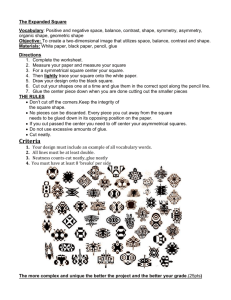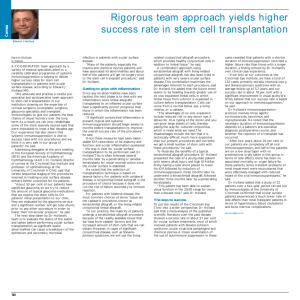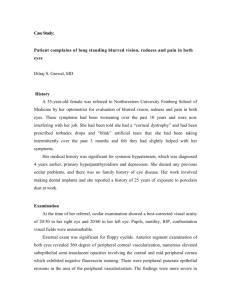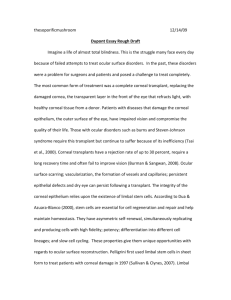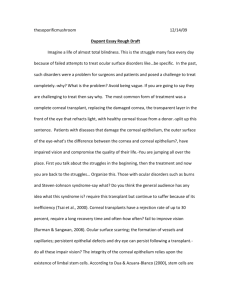Limbal Allograft Transplantation Using Fibrin Glue Narim
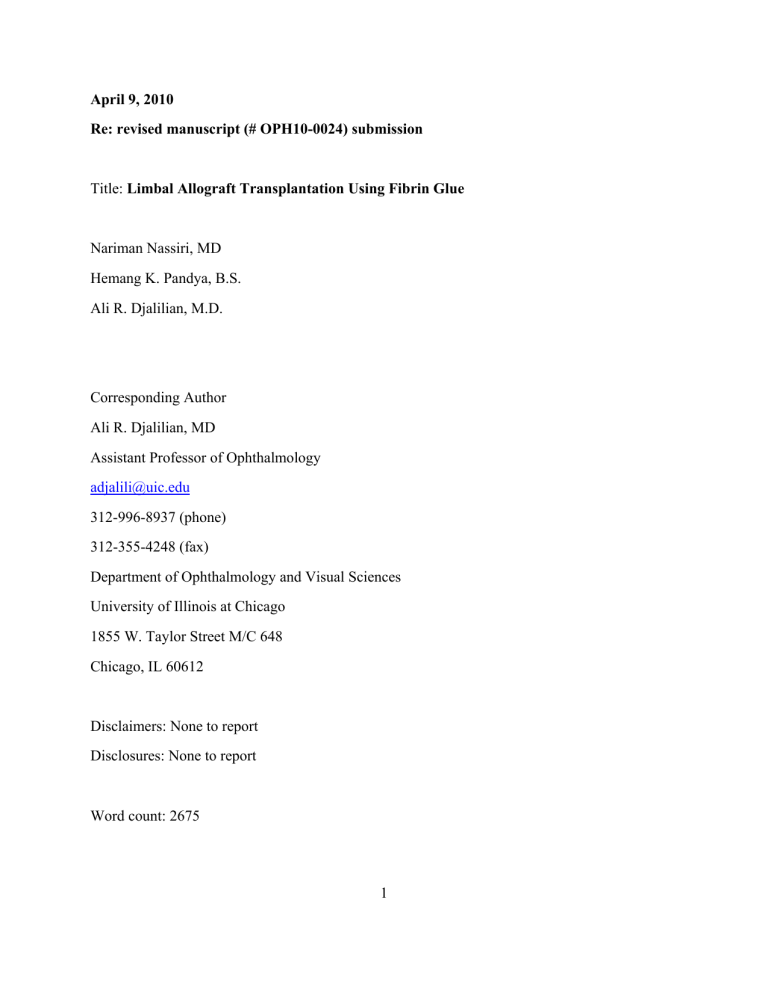
April 9, 2010
Re: revised manuscript (# OPH10-0024) submission
Title: Limbal Allograft Transplantation Using Fibrin Glue
Nariman Nassiri, MD
Hemang K. Pandya, B.S.
Ali R. Djalilian, M.D.
Corresponding Author
Ali R. Djalilian, MD
Assistant Professor of Ophthalmology adjalili@uic.edu
312-996-8937 (phone)
312-355-4248 (fax)
Department of Ophthalmology and Visual Sciences
University of Illinois at Chicago
1855 W. Taylor Street M/C 648
Chicago, IL 60612
Disclaimers: None to report
Disclosures: None to report
Word count: 2675
1
ABSTRACT
Limbal transplantation is now widely accepted as the treatment of advanced limbal stem cell deficiency. Herein, we describe a technique for harvesting thin limbal grafts from cadaveric corneoscleral rims and a sutureless method to secure the grafts to the recipient eye using fibrin glue. We report the results of fibrin glue assisted keratolimbal allograft (KLAL) in 19 eyes of 16 patients with the outcome measures of ocular surface stability, visual acuity, and post-operative complications. The results indicate that limbal allograft transplantation can be performed safely and successfully using only fibrin glue to secure the grafts. This can potentially improve surgical efficiency and patient comfort post-operatively.
Key Words: limbal stem cell deficiency, limbal stem cell transplantation, fibrin glue, keratolimbal allograft
2
INTRODUCTION
Limbal stem cell deficiency can develop following significant destruction of the limbal epithelial stem cells (e.g. chemical injury), or in conditions that impair the development or differentiation of the limbal stem cells (e.g. aniridia).
1 In limbal stem cell deficiency, the cornea becomes covered by ingrowing conjunctival epithelium leading to recurrent epithelial breakdown, neovascularization and scarring with subsequent loss of vision.
2 Limbal stem cell deficiency can be partial or total. While partial cases may be managed with more conservative measures, total limbal deficiency often requires a new supply of limbal stem cells. Limbal transplantation has been shown to restore a normal corneal phenotype in patients with total limbal stem cell deficiency.
3 Keratolimbal allograft (KLAL) is the surgical procedure of transplanting cadaveric limbal grafts for patients with bilateral limbal stem cell deficiency.
A number of techniques for KLAL have been reported, many of which describe strategies to facilitate harvesting the donor limbal grafts.
4-10 The technique described here uses cyanoacrylate glue to stabilize cadaver corneoscleral tissue during the donor dissection. The more novel part of our KLAL technique, however, is in securing the donor limbal grafts to the recipient eye with the use of only fibrin glue. Fibrin glue, which has been reported extensively in pterygium and other ocular surface surgeries, has not been described specifically for KLAL. The potential advantages of fibrin glue are well known and include significant reduction in operative times and improvement in patient comfort post-operatively. We hereby describe the surgical technique and outcome of KLAL using fibrin glue to secure the limbal allografts to the recipient eye.
3
METHODS
A retrospective review was conducted on 19 eyes (16 patients) with limbal stem cell deficiency who underwent fibrin glue assisted KLAL between January 2006 and June 2009.
Institutional Review Board (IRB) approval was obtained. The etiologies of limbal stem cell deficiency included congenital aniridia (14 eyes), chemical injuries (2 eyes), atopic keratoconjunctivitis (1 eye), radiation induced (1 eye), and idiopathic (1 eye). Three of the aniridic patients had previously undergone KLAL (with sutures) and had developed sectoral limbal stem cell deficiency due to partial rejection of the limbal grafts.
Preoperative evaluation included a complete ophthalmic exam including detailed evaluation of the tear film and the ocular surface. Limbal stem cell deficiency was diagnosed based on the clinical history and the clinical findings. The common findings included, loss of the limbal palisades; conjunctivalization of the corneal surface as evident by late staining opaque epithelium, superficial neovascularization, and non-healing corneal epithelial defects. Patients were also evaluated by their primary care provider or an organ transplant specialist to determine their eligibility for systemic immunosuppression. Patients with active ocular surface inflammation were treated prior to surgery with topical and systemic immunosuppression for a 3 month period or until their inflammation was well controlled. Written informed consent in accordance with the Declaration of Helsinki was obtained from all patients.
Surgical Procedure
All operations were performed by a single corneal surgeon (ARD) at the Cornea Service of the University of Illinois at Chicago (UIC).
4
Donor Tissue Preparation
For patients with total limbal stem cell deficiency, typically two donor corneas under 50 years of age and less than 5 days old were obtained from the Illinois Eye Bank. The tissue was specifically requested to have large scleral rims (> 3 mm) with as much conjunctiva as possible.
The central corneas from both donor corneoscleral buttons were removed using a 7.5mm trephine. Each rim was cut in half to produce a total of four 180-degree crescents. A thin layer of tissue N-butyl-2-cyanoacrylate adhesive (Indermil ® Tissue Adhesive, Tyco Healthcare Group
LP) was spread on a sterile plastic platform followed by a thin strip of viscoelastic (Viscoat ® ,
Alcon Laboratories) near the anterior edge of the adhesive (Fig. 1a) .
One of the donor corneoscleral crescents was placed epithelial side up on the adhesive and allowed to attach firmly onto the platform --the viscoelastic helps to prevent the glue from tracking up the anterior and lateral edges of the tissue. Starting from its free edge, the conjunctiva was lifted up and dissected off the sclera by cutting the underlying attachments using Wescott scissors. This dissection was carried forward up to the limbus after which using a crescent blade it was continued forward in the cornea in a lamellar fashion keeping at a depth of approximately one third to one fourth
(Fig.
1b)
. The same procedure was performed on two additional donor corneoscleral crescents all from the same donor ( video 1
).
Recipient Eye
The recipient eye was typically anesthetized with a peri- or retrobulbar injection -- occasionally general anesthesia was used. A 360-degree peritomy was performed with undermining and dissection of underlying adhesions. This allowed the conjunctiva to fall back and create space for the grafts. Superficial keratectomy was also performed to remove the
5
abnormal epithelium and fibrovascular pannus using a number 64 Beaver blade. Next, three 180degree donor limbal grafts were placed in close proximity to one another in order to cover the entire bed
(Fig. 2 a )
. Tisseel fibrin glue (Baxter AG, Vienna, Austria) was injected beneath the donor tissue. This was done using two separate syringes with fibrinogen injected first beneath the grafts followed by thrombin which was applied in drop wise fashion as well injected under the grafts. The excess glue was immediately “milked” from under the grafts using closed forceps
(Fig. 2b)
. After 2-3 minutes when the grafts appeared to be attached, any loose conjunctival tissue and excess fibrin glue was trimmed from the donor grafts. The host conjunctiva was approximated with the graft and sometimes pulled over on top of the donor conjunctiva (video2) .
At the conclusion, a subconjunctival injection of 0.5 ml of dexamethasone (10mg/ml) and 0.5 ml of cephazolin (100mg/ml) was given, and an neomycin, polymyxin B and dexamethasone ointment was placed in the eye. The eye was patched and a shield was placed over the eye until the following day.
In the first 3 eyes, given the uncertainty with the fibrin glue, one or two sutures were used just to hold the grafts together and minimize the possibility of a gap forming between the grafts, while in the remaining 16 eyes no sutures were used at all.
Postoperative management
Immediately post-operatively all patients received topical pednisolone acetate 1% four times a day, gatifloxacin (Zymar, Allergan, Irvine, CA) 4 times a day, and frequent lubrication with non-preserved artificial tears. Once the corneal epithelial defect had healed, the antibiotics were stopped and the patients were started on cyclosporine 0.05% (Restasis, Allergan, Irvine,
CA) two to three times a day. All patients were additionally placed on systemic
6
immunosuppression consisting of oral prednisone 1 mg/kg/day, tacrolimus 4 mg b.i.d.
(cyclosporin 3 mg/kg/day in 2 cases), and mycophenolate mofetil 500 -1000 mg b.i.d. (or azathioprine 100 mg/day in 2 cases) starting in the evening of the day of surgery or sooner depending on the level of inflammation. The oral prednisone was typically tapered off by 3 – 4 months while the other two agents were continued for a minimum of 18-24 months.
The primary outcome measure was ocular surface stability followed by visual acuity, and post-operative complications. Ocular surface stability was defined as the absence of conjunctivalization, no recurrent epithelial defects, and no corneal neovascularization. Failures were defined as the presence of abnormally high fluorescein permeability with diffuse late staining epithelium, recurrence of conjunctivalization, increased neovascularization , and persistent or recurrent epithelial defects.
7
RESULTS
A total of 19 procedures were performed on 16 patients (Male: 6; Female: 10) with the mean age of 44.1 (range, 12-81) years. The procedures included KLAL (15 cases), sectoral
(only 180 degrees) KLAL (3 cases), and combined KLAL/CLAU (1 case). The mean follow-up was 17.3 ± 7.2 (range 7 to 31) months. The mean epithelial healing time was 8.4 ± 4 days
(range: 5 to 22 days) excluding one patient with a history of squamous cell carcinoma and extensive eyelid tissue loss whose epithelial defect never healed and was ultimately considered a failure at 2 months after surgery. The mean best corrected visual acuity improved from
20/900 (range: 20/200-20/3200) preoperatively to 20/300 (range: 20/80-20/1600) postoperatively (p=0.001) with 15 (78.9%) cases showing an improvement of ≥ 2 snellen lines.
At last follow-up, 15 of the 19 eyes had maintained a stable ocular surface. There were a total of 4 limbal transplant failures, 3 of which were due to rejection in younger aniridic patients (ages 19, 25, and 41). The other failure was due to inadequate lid closure in a patient with a history of extensive eyelid resection and radiation induced limbal stem cell deficiency.
The mean time of failure was 7.5 (range 2-12) months and all occurred in the first year after surgery. Cumulative survival of the ocular surface transplantation (ocular surface stability) was
76.9 %.
There were no intra-operative or immediate post-operative complications. Of note, there were no graft detachments or major displacements. Two patients developed a conjunctival inclusion cyst near the posterior edge of the graft that diminished over time. Pre-operatively, 11 patients had a history of glaucoma, of which 6 had previously undergone surgery (5 tube shunts,
1 diode laser). Postoperatively, the intraocular pressure increased in 7 patients, which were all in the patients with pre-existing glaucoma. In all cases, the pressure was controlled medically
.
8
COMMENT
Limbal stem cell transplantation is currently the main surgical treatment for visually disabling limbal stem cell deficiency. KLAL is typically considered in patients with bilateral disease who are also candidates for systemic immunosuppression. The surgical procedure for
KLAL consists of two parts, the donor tissue dissection and the recipient eye surgery.
Technically, preparing the donor tissue by lamellar dissection is one of the challenging aspects of the surgical procedure. A number of different techniques have been described to facilitate the donor dissection. One of the earlier techniques was to dissect the limbal tissue from a whole globe.
4 Dissecting limbal grafts from a corneoscleral tissue that is not stabilized often requires an assistant to hold the tissue.
11 One strategy to stabilize the tissue is to use an artificial anterior chamber and dissect the tissue manually or by a microkeratome.
5,6 Mannis et al.
7 described using a standard silicone orbital sizing sphere and three 25-gauge needles to fix the corneoscleral button. Aldave and Wong 8 used cyanoacrylate glue to secure a corneoscleral rim to a disposable acrylic sphere. Meisler et al.
9 presented a device to secure corneoscleral buttons using suction.
More recently, Lim et al.
10 have described a technique similar to ours using cyanoacrylate glue to secure 180 degree corneoscleral crescents to a flat surface.
The dissection technique described here may offer some potential advantages. First, when harvesting the donor tissue, only conjunctiva and some Tenon’s capsule is taken and typically there is minimal scleral tissue in the graft. As a result, the transplanted tissue is much thinner compared to other techniques described to date. A thin graft which is not elevated above the cornea and sclera, is desirable in part because it avoids having a large “step off” which can
occasionally lead to dellen or epithelial healing problems. Likewise, the donor sclera is often not visible after transplantation as with many other techniques and over the long term, the
9
conjunctival edge blends nicely with the surrounding conjunctiva ( Figure 3 ). Finally, a thin graft can be easily secured to the recipient cornea and sclera using only fibrin glue.
Fibrin glue is a tissue adhesive based on the two biological components of the coagulation cascade, fibrinogen and thrombin. Upon contact with each other, thrombin converts fibrinogen to fibrin which is rapidly polymerized leading to hemostasis and tissue adhesion. The use of fibrin glue in ophthalmology dates back more than twenty years.
12 It is used commonly in conjunctival surgery to secure a conjunctival autograft or amniotic membrane graft after pterygium excision. Likewise, it has been used for other ocular surface reconstructive procedures in particular amniotic membrane transplantation.
13-17 The advantages of using fibrin glue in ocular surgery are well known and include a decrease in operative time and postoperative pain.
18-20 Postoperatively, not having sutures is also advantageous since sutures can induce inflammation and occasionally provide a nidus for infection or neovascularization. There is only one published report on the use of fibrin glue for “limbal stem cell transplantation”, however that study involved conjunctival limbal autografts mainly after pterygium excision and included only a few cases of total limbal stem cell deficiency.
21 While, the results presented in this study involved KLAL, we have used fibrin glue successfully to secure conjunctival limbal autografts for unilateral cases of limbal stem cell deficiency (unpublished data). Actually, one of the patients in our series underwent a combined KLAL and CLAU for extensive limbal and conjunctival deficiency.
Since the components of fibrin glue are often derived from pooled human plasma, there is a theoretical risk of human disease transmission. However, there have not been any documented cases of disease transmission despite extensive use of these products in various surgical fields.
22
10
Thus, the risk appears to be minimal. It should also be mentioned that the use of fibrin glue for ocular surface procedures is considered an off label use of this product.
A feature of our technique, which is modeled after the technique described by Holland and co-workers, is the use of three 180-degree donor tissues.
11 This provides more stem cells for the recipient eye compared to a standard 360 technique. The extra graft also provides more tissue to cover the ocular surface in patients with extensive conjunctival deficiency. It also results in a larger corneal surface untouched by the limbal graft and may provide improved vision or better surface for contact lens wear. In this technique, it is crucial to place the three 180-degree donor tissues immediately adjacent to one another in order to avoid any gaps between tissues which could allow conjunctival invasion onto the surface. This overcomes the disadvantage of using only two 180-degree grafts like Lim et al.
10 which can leave gap areas between the donor tissues.
Technically, the procedure described here, may be considered a conjunctival-limbal allograft (CLAL), given the generous amount of conjunctiva which is included in the graft.
However, since the transplanted conjunctiva is not always viable and the procedure is used primarily to reconstruct the limbus, we have chosen to keep the name KLAL, in part because it is the more familiar term in the literature.
An important technical consideration in this procedure is the position of the donor and host conjunctival edges. It is recommended that the host and donor conjunctiva be well approximated to each other or to have the host conjunctiva slightly pulled over the donor conjunctiva. This avoids the possibility of host conjunctival growth under the grafts while also preventing the formation of inclusion cysts. Two patients in this study developed an inclusion
11
cyst both of which diminished without intervention.
Other than the use of fibrin glue intraoperatively, our postoperative management of patients is the same as standard KLAL. In particular, the patients must receive systemic immunosuppression in order to prevent immune rejection of the allograft tissue. Currently, we use the same protocols as published by the Holland group with a regimen consisting of systemic steroids, tacrolimus, and mycophenolate.
23 Co-management with an organ transplant team with experience in the use of immunosuppressive medications is highly recommended for this purpose.
Postoperatively, 78.9% cases showed a significant improvement of visual acuity from baseline which is comparable to the 30-67% reported by previous studies.
24 It is important to note that the final visual acuities in many patients may be limited by optic nerve or retinal pathology, especially in our series which included a significant number of patients with aniridia.
Graft survival rates for KLAL have been quoted at 33 to 84%.
24 In our study, the graft survival was 76.9 % after follow-up time of 31 months. Long-term studies are still needed to determine the ultimate fate of the transplanted limbal grafts.
In summary, a technique for dissecting limbal allografts and securing them to the recipient limbus using fibrin glue has been described. The early results appear comparable to previous reports. The use of fibrin glue in KLAL can potentially enhance surgical efficiency, and improve patient comfort postoperatively.
12
REFERENCES
1Holland EJ. Epithelial transplantation for the management of severe ocular surface disease. Trans Am Ophthalmol Soc. 1996;94:677-743.
2Puangsricharern V, Tseng SC. Cytologic evidence of corneal diseases with limbal stem cell deficiency. Ophthalmology. 1995 Oct;102(10):1476-85.
3Liang L, Sheha H, Tseng SC. Long-term outcomes of keratolimbal allograft for total limbal stem cell deficiency using combined immunosuppressive agents and correction of ocular surface deficits. Arch Ophthalmol. 2009 Nov;127(11):1428-34.
4Thoft RA. .Keratoepithelioplasty. Am J Ophthalmol. 1984 Jan;97(1):1-6.
5Tsubota K, Toda I, Saito H, et al. Reconstruction of the corneal epithelium by limbal allograft transplantation for severe ocular surface disorders. Ophthalmology
1995;102:1486–96.
6Chuck RS, Behrens A, McDonnell PJ. Microkeratome-based limbal harvester for limbal stem cell transplantation: preliminary studies. Am J Ophthalmol 2001;131:377–8.
7Mannis MJ, McCarthy M, Izquierdo L Jr. Technique for harvesting keratolimbal allografts from corneoscleral buttons. Am J Ophthalmol 1999;128:237–8.
8Aldave AJ, Wong IG. A novel technique for harvesting keratolimbal allografts from corneoscleral buttons. Am J Ophthalmol 2002;134:929–31.
9Meisler DM, Perez VL, Proudfit J. A device to facilitate limbal stem cell procurement from eye bank donor tissue for keratolimbal allograft procedures. Am J Ophthalmol.
2005 Jan;139(1):212-4.
13
10Lim LT, Bhatt PR, Ramaesh K. Harvesting keratolimbal allografts from corneoscleral buttons: a novel application of cyanoacrylate adhesive. Br J Ophthalmol 2008;92:1550–
1551.
11Croasdale CR, Schwartz GS, Malling JV, et al. Keratolimbal allograft: recommendations for tissue procurement and preparation by eye banks, and standard surgical technique.
Cornea 1999;18:52–8.
12Zauberman H, Hemo I, Use of Fibrin glue in ocular surgery. Ophthalmic Surg
1988;19:132-3
13Kim HK, Park HS. Fibrin glue-assisted augmented amniotic membrane transplantation for the treatment of large noninfectious corneal perforations. Cornea. 2009
Feb;28(2):170-6.
14Esquenazi S, Rand W, Velazquez G, Grunstein L. Novel therapeutic approach in the management of band keratopathy using amniotic membrane transplantation with fibrin glue. Ophthalmic Surg Lasers Imaging. 2008 Sep-Oct;39(5):418-21.
15Kheirkhah A, Casas V, Blanco G, Li W, Hayashida Y, Chen YT, Tseng SC. Amniotic membrane transplantation with fibrin glue for conjunctivochalasis. Am J Ophthalmol.
2007 Aug;144(2):311-3.
16Uhlig CE, Busse H, Groppe M. Use of fibrin glue in fixation of amniotic membranes in sterile corneal ulceration. Am J Ophthalmol. 2006 Jul;142(1):189-91.
17Kheirkhah A, Blanco G, Casas V, Hayashida Y, Raju VK, Tseng SC. Surgical strategies for fornix reconstruction based on symblepharon severity. Am J Ophthalmol. 2008
Aug;146(2):266-275..
14
18Srinivasan S, Dollin M, McAllum P, Berger Y, Rootman DS, Slomovic AR. Fibrin glue versus sutures for attaching the conjunctival autograft in pterygium surgery: a prospective observer masked clinical trial. Cornea 2009;28:43–45.
19Ozdamar Y, Mutevelli S, Han U, et al. A comparative study of tissue glue and vicryl suture for closing limbal-conjunctival autografts and histologic evaluation after pterygium excision. Cornea. 2008 Jun;27(5):552-8.
20Uy HS, Reyes Jm, Flores JD, et al. Comparison of fibrin glue and sutures for attaching conjunctival autografts after pterygium excision. Ophthalmology. 2005;112:667–671.
21Pfister RR, Sommers CI. Fibrin sealant in corneal stem cell transplantation. Cornea. 2005
Jul;24(5):593-8.
22Horowitz B, Busch M. Estimating the pathogen safety of manufactured human plasma products: application to fibrin sealants and to thrombin. Transfusion. 2008
Aug;48(8):1739-53.
23Djalilian AR, Wadia HP, Balali S, Nassiri N, Holland EJ. Epithelial Transplantation for the Management of Severe Ocular Surface Disease. In: Brightbill FS, Mcdonnell PJ,
Mcghee CJ, et al. editors. Corneal Surgery: Theory, Technique and Tissue; 4 th Ed.
Missouri: Mosby, 2008:241-258.
24Cauchi PA, Ang GS, Azuara-Blanco A, Burr JM. A systematic literature review of surgical interventions for limbal stem cell deficiency in humans. Am J Ophthalmol. 2008
Aug;146(2):251-259.
15
Figure legends
Figure 1. Donor tissue preparation for KLAL
1a.
A thin strip of viscoelastic ( A ) placed near the edge of the N-butyl-2-cyanoacrylate adhesive
(Indermil®, Tyco Healthcare)
(B)
on a sterile plastic platform.
16
1b. securing After the tissue to the surface, superficial lamellar dissection is carried forward onto the cornea extending at least 1 mm anterior to the limbus, using a crescent blade.
Figure 2. Recipient eye KLAL surgery.
17
2a.
Three 180-degrees limbal donor grafts (A, B, C) are placed in close proximity to one another in order to cover the entire bed (piece A was slightly trimmed in order to fit).
2b.
The fibrin glue is injected beneath the donor tissue in order to attach them to the corneoscleral bed.
18
Figure 3 . The pre-operative cornea (a) of the aniridic patient presented in Figures 1 and 2 demonstrating an irregular epithelium, fine peripheral neovascularization and subepithelial nodules (taken 1 year prior to surgery). The postoperative cornea of the same patient at 25 months (b) after surgery. The corneal epithelium is stable with barely visible conjunctival-limbal allografts. Of note, cortical remnants from old cataract surgery is visible in the anterior chamber.
19
Figure 4. The cumulative probability of Keratolimbal allograft success analyzed by Kaplan-
Meier life-table analysis.
20



